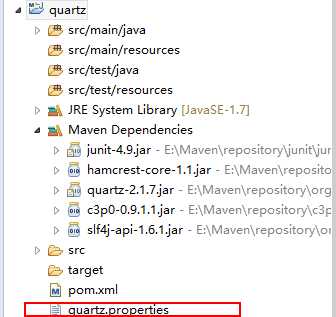将可变信息放在properties文件是使配置更加灵活。
1.文档位置和加载顺序
1. StdSchedulerFactory默认加载quartz包下的quartz.properties文件,如果我们在项目下面新建一个quartz.properties文件,会优先加载我们的配置文件。
quartz包下的quartz.properties文件内容:
# Default Properties file for use by StdSchedulerFactory # to create a Quartz Scheduler Instance, if a different # properties file is not explicitly specified. # org.quartz.scheduler.instanceName: DefaultQuartzScheduler org.quartz.scheduler.rmi.export: false org.quartz.scheduler.rmi.proxy: false org.quartz.scheduler.wrapJobExecutionInUserTransaction: false org.quartz.threadPool.class: org.quartz.simpl.SimpleThreadPool org.quartz.threadPool.threadCount: 10 org.quartz.threadPool.threadPriority: 5 org.quartz.threadPool.threadsInheritContextClassLoaderOfInitializingThread: true org.quartz.jobStore.misfireThreshold: 60000 org.quartz.jobStore.class: org.quartz.simpl.RAMJobStore
2. 现在我们测试我们自己在工程目录下新建一个quartz.propertis文件是否优先读取我们的配置文件:

内容:主要是将线程数量修改为-5
# Default Properties file for use by StdSchedulerFactory # to create a Quartz Scheduler Instance, if a different # properties file is not explicitly specified. # org.quartz.scheduler.instanceName: DefaultQuartzScheduler org.quartz.scheduler.rmi.export: false org.quartz.scheduler.rmi.proxy: false org.quartz.scheduler.wrapJobExecutionInUserTransaction: false org.quartz.threadPool.class: org.quartz.simpl.SimpleThreadPool org.quartz.threadPool.threadCount: -5 org.quartz.threadPool.threadPriority: 5 org.quartz.threadPool.threadsInheritContextClassLoaderOfInitializingThread: true org.quartz.jobStore.misfireThreshold: 60000 org.quartz.jobStore.class: org.quartz.simpl.RAMJobStore
3.我们再次启动quartz任务:
Job定义:
package cn.qlq.quartz; import java.text.SimpleDateFormat; import java.util.Date; import org.quartz.Job; import org.quartz.JobExecutionContext; import org.quartz.JobExecutionException; public class HelloJob implements Job { public void execute(JobExecutionContext context) throws JobExecutionException { try { Thread.sleep(5000); } catch (InterruptedException e) { // TODO Auto-generated catch block e.printStackTrace(); } //打印当前的时间 SimpleDateFormat sf = new SimpleDateFormat("yyyy-MM-dd hh:mm:ss"); Date date = new Date(); System.out.println("current exec time is :"+sf.format(date)); } }
package cn.qlq.quartz; import static org.quartz.JobBuilder.newJob; import java.text.SimpleDateFormat; import java.util.Date; import org.quartz.CronScheduleBuilder; import org.quartz.CronTrigger; import org.quartz.JobDetail; import org.quartz.Scheduler; import org.quartz.SchedulerFactory; import org.quartz.TriggerBuilder; import org.quartz.impl.StdSchedulerFactory; public class HelloScheduler { public static void main(String[] args) { try { // 1. 创建一个JodDetail实例 将该实例与Hello job class绑定 (链式写法) JobDetail jobDetail = newJob(HelloJob.class) // 定义Job类为HelloQuartz类,这是真正的执行逻辑所在 .withIdentity("myJob") // 定义name/group .build(); // 打印当前的时间 SimpleDateFormat sf = new SimpleDateFormat("yyyy-MM-dd hh:mm:ss"); Date date = new Date(); System.out.println("current time is :" + sf.format(date)); // 2. 2018年内每天11点18开始执行,每隔5s执行一次 CronTrigger trigger = (CronTrigger) TriggerBuilder.newTrigger() .withIdentity("myTrigger", "group1")// 定义名字和组 .withSchedule( //定义任务调度的时间间隔和次数 CronScheduleBuilder .cronSchedule("* * * * * ? *") ) .build(); // 3. 创建scheduler SchedulerFactory sfact = new StdSchedulerFactory(); Scheduler scheduler = sfact.getScheduler(); // 4. 将trigger和jobdetail加入这个调度 scheduler.scheduleJob(jobDetail, trigger); // 5. 启动scheduler scheduler.start(); } catch (Exception e) { e.printStackTrace(); } } }
结果: (报错,说线程数必须大于0)
current time is :2018-04-05 12:45:55 org.quartz.SchedulerConfigException: Thread count must be > 0 at org.quartz.simpl.SimpleThreadPool.initialize(SimpleThreadPool.java:245) at org.quartz.impl.StdSchedulerFactory.instantiate(StdSchedulerFactory.java:1273) at org.quartz.impl.StdSchedulerFactory.getScheduler(StdSchedulerFactory.java:1502) at cn.qlq.quartz.HelloScheduler.main(HelloScheduler.java:39)
二、quartz.properties文件详解:
1.quartz.properties组成部分
调度器属性 线程池属性 作业存储设置 插件配置
2. 调度器属性

3.线程池属性
threadCount:工作线程数量
threadPriority:工作线程优先级
org.quartz.threadPool.class:配置线程池实现类
4.作业存储设置
描述了在调度器实例的生命周期中,Job和Trigger信息是如何被存储的
5. 插件配置
满足特定需求用到的Quartz插件的配置
6.最后附一个项目中常用的配置quartz.properties
# Default Properties file for use by StdSchedulerFactory
# to create a Quartz Scheduler Instance, if a different
# properties file is not explicitly specified.
#
# ===========================================================================
# Configure Main Scheduler Properties 调度器属性
# ===========================================================================
org.quartz.scheduler.instanceName: DefaultQuartzScheduler
org.quartz.scheduler.instanceid:AUTO
org.quartz.scheduler.rmi.export: false
org.quartz.scheduler.rmi.proxy: false
org.quartz.scheduler.wrapJobExecutionInUserTransaction: false
# ===========================================================================
# Configure ThreadPool 线程池属性
# ===========================================================================
#线程池的实现类(一般使用SimpleThreadPool即可满足几乎所有用户的需求)
org.quartz.threadPool.class: org.quartz.simpl.SimpleThreadPool
#指定线程数,至少为1(无默认值)(一般设置为1-100直接的整数合适)
org.quartz.threadPool.threadCount: 10
#设置线程的优先级(最大为java.lang.Thread.MAX_PRIORITY 10,最小为Thread.MIN_PRIORITY 1,默认为5)
org.quartz.threadPool.threadPriority: 5
#设置SimpleThreadPool的一些属性
#设置是否为守护线程
#org.quartz.threadpool.makethreadsdaemons = false
#org.quartz.threadPool.threadsInheritContextClassLoaderOfInitializingThread: true
#org.quartz.threadpool.threadsinheritgroupofinitializingthread=false
#线程前缀默认值是:[Scheduler Name]_Worker
#org.quartz.threadpool.threadnameprefix=swhJobThead;
# 配置全局监听(TriggerListener,JobListener) 则应用程序可以接收和执行 预定的事件通知
# ===========================================================================
# Configuring a Global TriggerListener 配置全局的Trigger监听器
# MyTriggerListenerClass 类必须有一个无参数的构造函数,和 属性的set方法,目前2.2.x只支持原始数据类型的值(包括字符串)
# ===========================================================================
#org.quartz.triggerListener.NAME.class = com.swh.MyTriggerListenerClass
#org.quartz.triggerListener.NAME.propName = propValue
#org.quartz.triggerListener.NAME.prop2Name = prop2Value
# ===========================================================================
# Configuring a Global JobListener 配置全局的Job监听器
# MyJobListenerClass 类必须有一个无参数的构造函数,和 属性的set方法,目前2.2.x只支持原始数据类型的值(包括字符串)
# ===========================================================================
#org.quartz.jobListener.NAME.class = com.swh.MyJobListenerClass
#org.quartz.jobListener.NAME.propName = propValue
#org.quartz.jobListener.NAME.prop2Name = prop2Value
# ===========================================================================
# Configure JobStore 存储调度信息(工作,触发器和日历等)
# ===========================================================================
# 信息保存时间 默认值60秒
org.quartz.jobStore.misfireThreshold: 60000
#保存job和Trigger的状态信息到内存中的类
org.quartz.jobStore.class: org.quartz.simpl.RAMJobStore
# ===========================================================================
# Configure SchedulerPlugins 插件属性 配置
# ===========================================================================
# 自定义插件
#org.quartz.plugin.NAME.class = com.swh.MyPluginClass
#org.quartz.plugin.NAME.propName = propValue
#org.quartz.plugin.NAME.prop2Name = prop2Value
#配置trigger执行历史日志(可以看到类的文档和参数列表)
org.quartz.plugin.triggHistory.class = org.quartz.plugins.history.LoggingTriggerHistoryPlugin
org.quartz.plugin.triggHistory.triggerFiredMessage = Trigger {1}.{0} fired job {6}.{5} at: {4, date, HH:mm:ss MM/dd/yyyy}
org.quartz.plugin.triggHistory.triggerCompleteMessage = Trigger {1}.{0} completed firing job {6}.{5} at {4, date, HH:mm:ss MM/dd/yyyy} with resulting trigger instruction code: {9}
#配置job调度插件 quartz_jobs(jobs and triggers内容)的XML文档
#加载 Job 和 Trigger 信息的类 (1.8之前用:org.quartz.plugins.xml.JobInitializationPlugin)
org.quartz.plugin.jobInitializer.class = org.quartz.plugins.xml.XMLSchedulingDataProcessorPlugin
#指定存放调度器(Job 和 Trigger)信息的xml文件,默认是classpath下quartz_jobs.xml
org.quartz.plugin.jobInitializer.fileNames = my_quartz_job2.xml
#org.quartz.plugin.jobInitializer.overWriteExistingJobs = false
org.quartz.plugin.jobInitializer.failOnFileNotFound = true
#自动扫描任务单并发现改动的时间间隔,单位为秒
org.quartz.plugin.jobInitializer.scanInterval = 10
#覆盖任务调度器中同名的jobDetail,避免只修改了CronExpression所造成的不能重新生效情况
org.quartz.plugin.jobInitializer.wrapInUserTransaction = false
# ===========================================================================
# Sample configuration of ShutdownHookPlugin ShutdownHookPlugin插件的配置样例
# ===========================================================================
#org.quartz.plugin.shutdownhook.class = \org.quartz.plugins.management.ShutdownHookPlugin
#org.quartz.plugin.shutdownhook.cleanShutdown = true
#
# Configure RMI Settings 远程服务调用配置
#
#如果你想quartz-scheduler出口本身通过RMI作为服务器,然后设置“出口”标志true(默认值为false)。
#org.quartz.scheduler.rmi.export = false
#主机上rmi注册表(默认值localhost)
#org.quartz.scheduler.rmi.registryhost = localhost
#注册监听端口号(默认值1099)
#org.quartz.scheduler.rmi.registryport = 1099
#创建rmi注册,false/never:如果你已经有一个在运行或不想进行创建注册
# true/as_needed:第一次尝试使用现有的注册,然后再回来进行创建
# always:先进行创建一个注册,然后再使用回来使用注册
#org.quartz.scheduler.rmi.createregistry = never
#Quartz Scheduler服务端端口,默认是随机分配RMI注册表
#org.quartz.scheduler.rmi.serverport = 1098
#true:链接远程服务调度(客户端),这个也要指定registryhost和registryport,默认为false
# 如果export和proxy同时指定为true,则export的设置将被忽略
#org.quartz.scheduler.rmi.proxy = false
